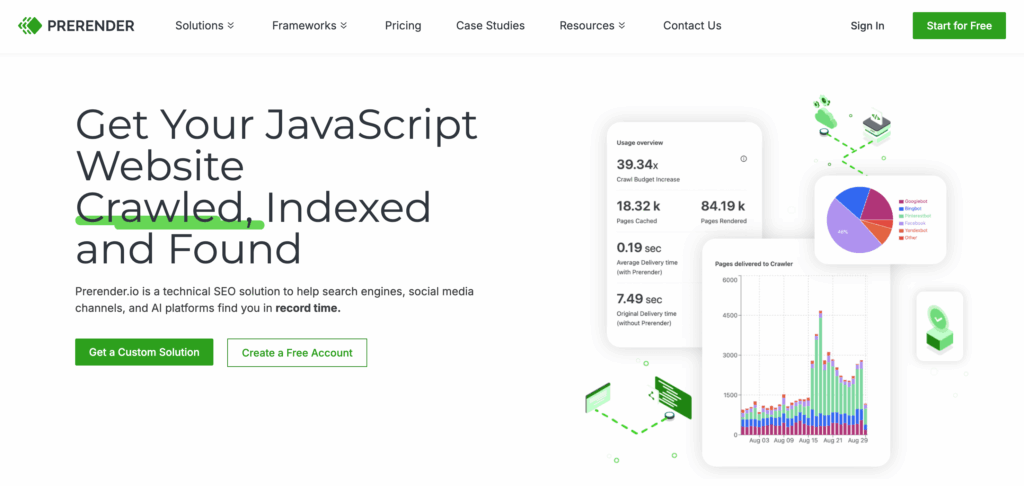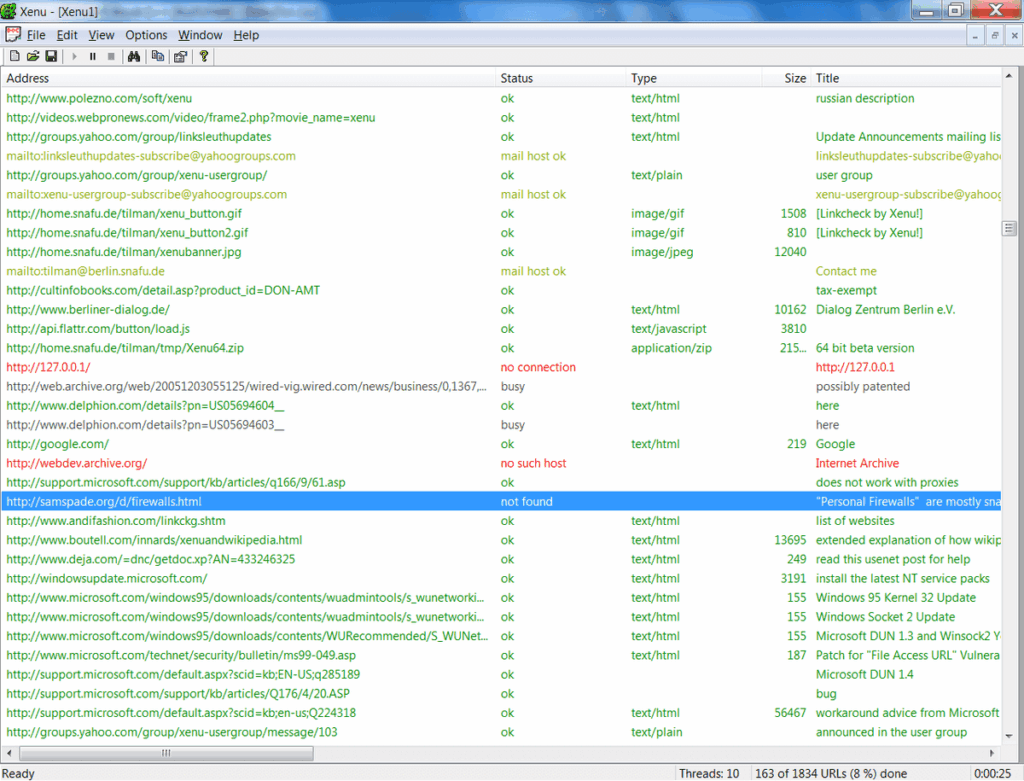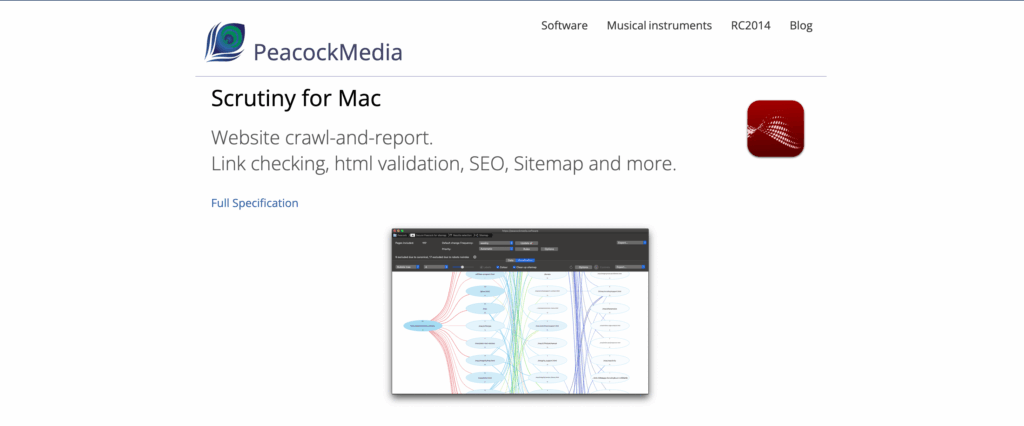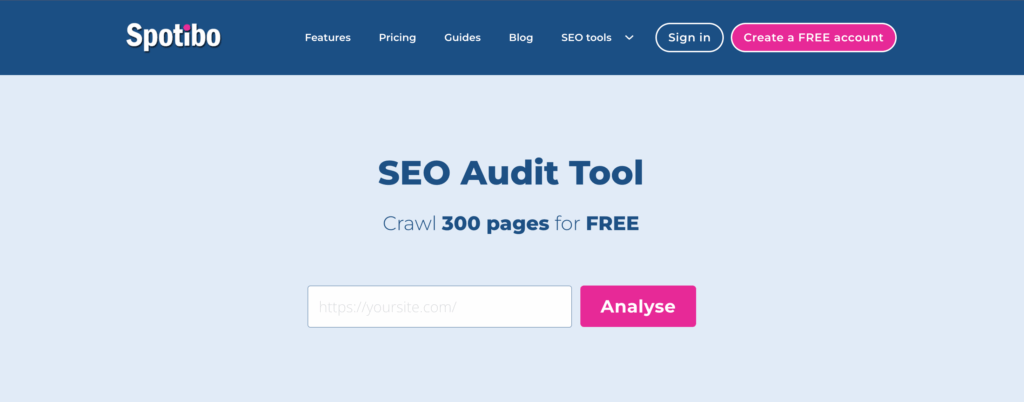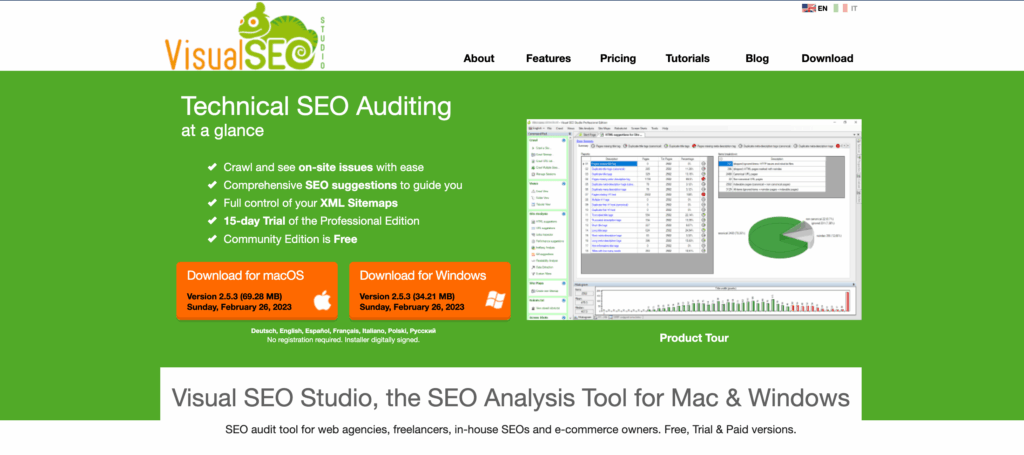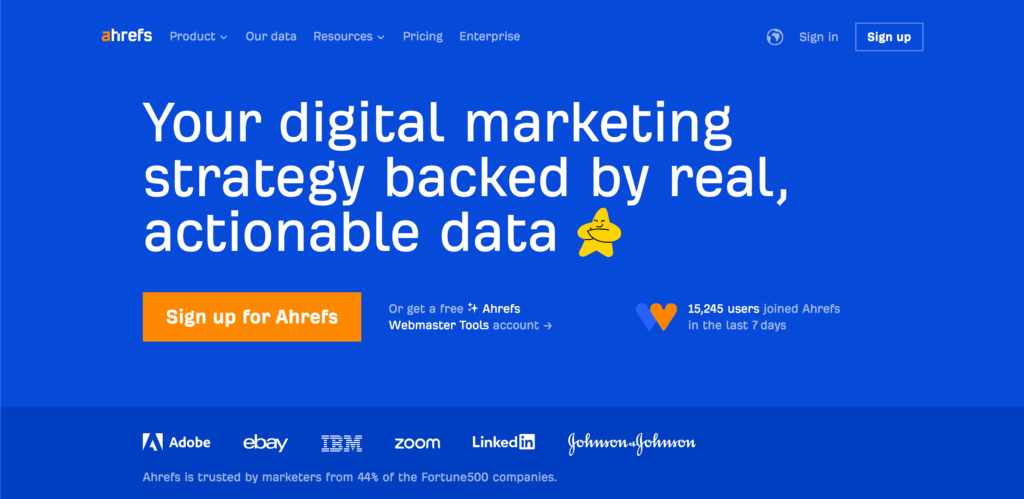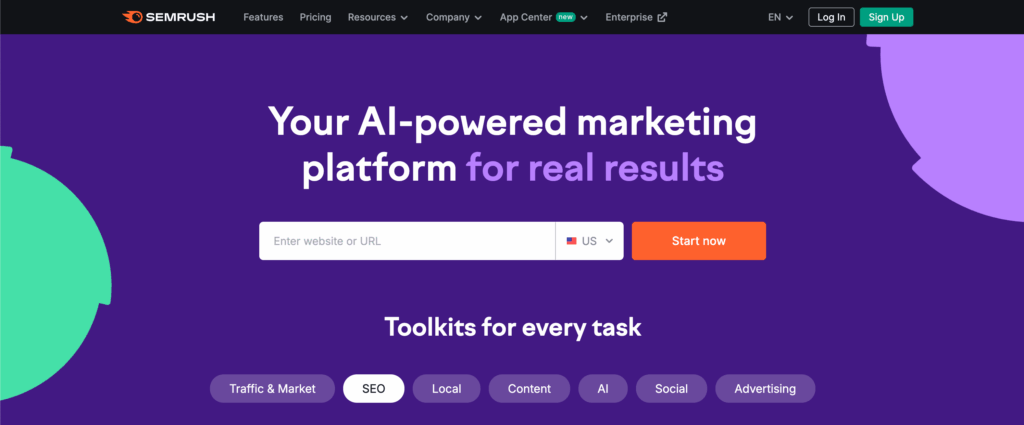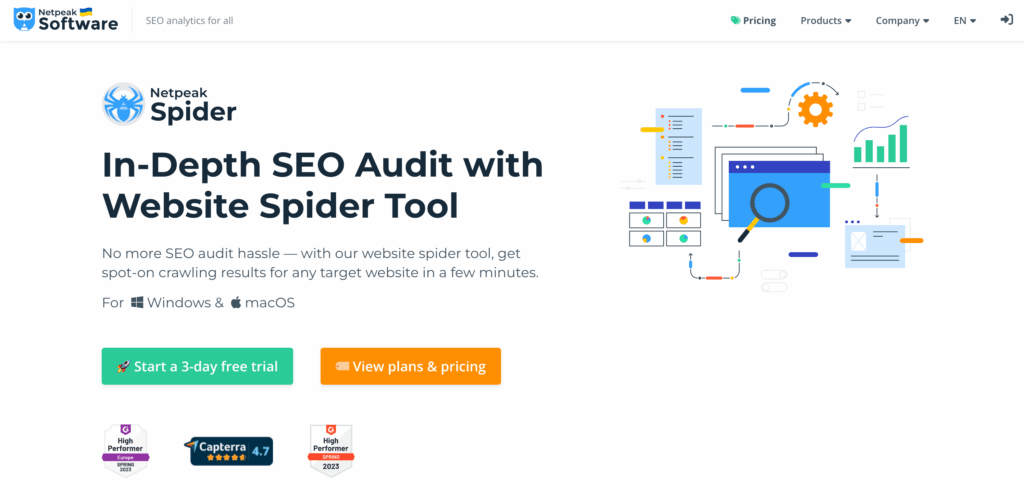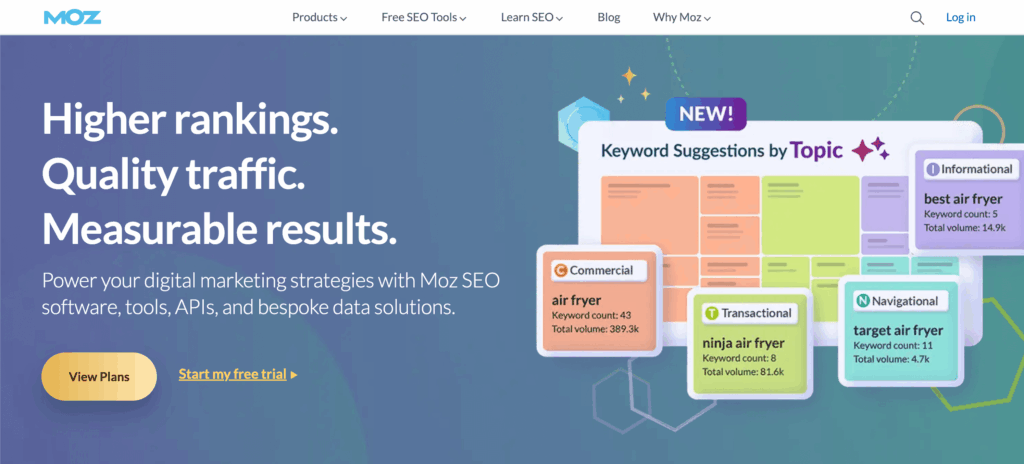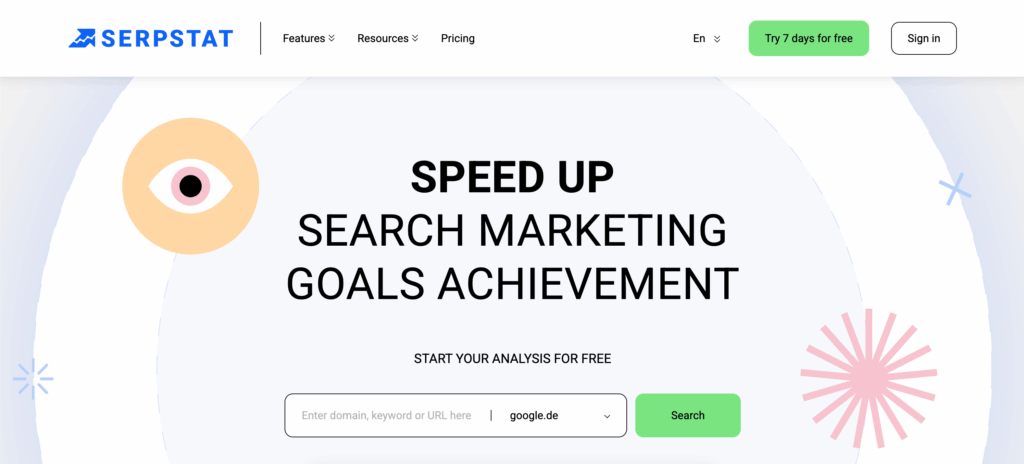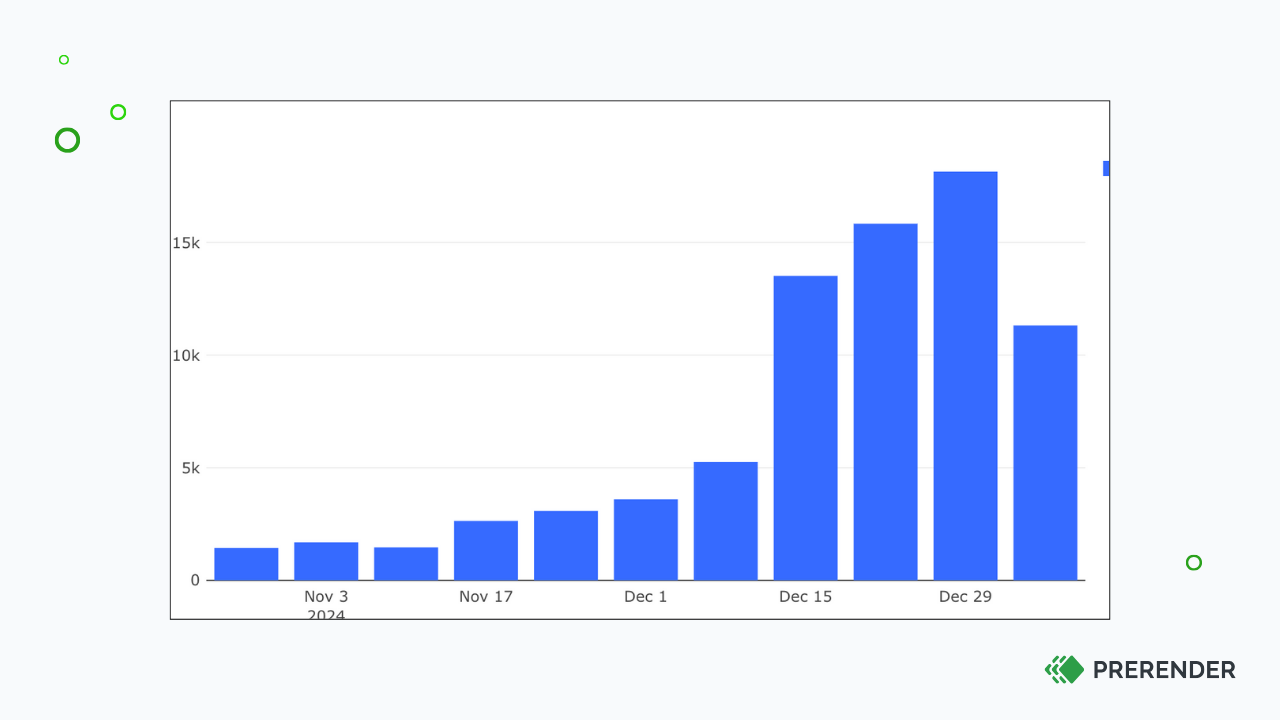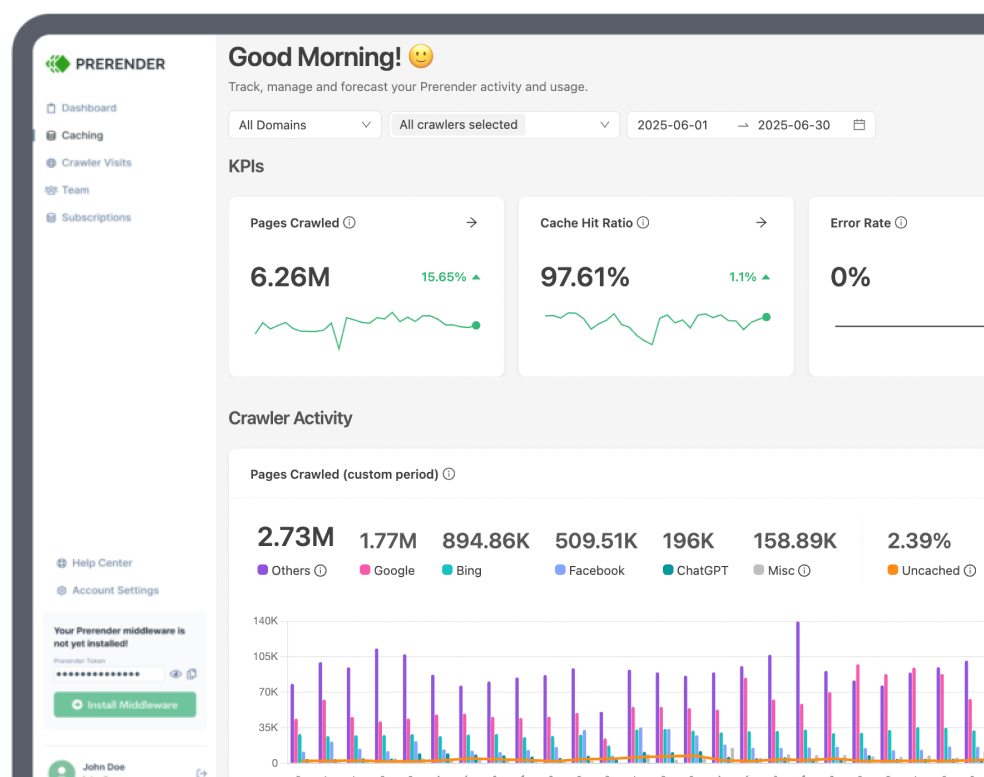Screaming Frog remains one of the most trusted SEO crawling tools for technical audits. Its SEO Spider helps marketers detect broken links, duplicate content, and metadata issues across entire websites.
But it isn’t perfect. Between its desktop-only setup, crawl limits, and performance constraints on large sites, many SEO teams look for Screaming Frog alternatives, especially cloud-based tools that can handle faster, automated crawls.
In this guide, we compare the 10 best Screaming Frog alternatives (both free and paid), their pros and cons, and which use case each one fits best. Some of the top alternatives for Screaming Frog includes Prerender.io, Spotibo, Ahrefs, and Semrush.
Screaming Frog‘s Limitations: Why You Might Need an Alternative
Despite its power, Screaming Frog isn’t always the most scalable or beginner-friendly solution. While Screaming Frog SEO Spider is widely regarded as the industry-standard web crawler, its functional limitations mean it isn’t universally favored among SEO professionals.
- Desktop-only crawling: its desktop-based operation can slow down a computer during site crawls, and its site crawl efficiency can be hampered by low computer specifications.
- Not suitable for extremely large websites: some users claim that Screaming Frog’s SEO spider isn’t powerful enough to crawl websites with thousands of URLs. They often run into errors, interrupting the SEO site review process.
- Too technical for beginners: inexperienced SEOs may find the tool overwhelming. Additionally, the free plan’s 500-URL crawl limit is also quickly reached. Once you cross that threshold, you have to switch to a paid plan to continue, which can strain those with a small budget.
Want to get more out of your existing setup? Explore 13 Screaming Frog Features and Tricks You Didn’t Know to enhance your audits before you switch tools.
Best Free Screaming Frog Alternatives (Lightweight SEO Crawlers)
If you’re just starting out or have a smaller site, these free Screaming Frog alternatives offer excellent value without heavy setup or subscription costs.
1. Prerender.io: Best for Site Crawl and JavaScript Rendering
Prerender.io is not a dedicated web crawler tool like Screaming Frog. Unlike most crawlers, it doesn’t just identify crawl issues; it fixes them at the source by rendering your JavaScript content for search engines and AI crawlers.
While Screaming Frog focuses on identifying SEO issues, Prerender.io actually resolves them: bridging the gap between technical SEO, AI visibility, and performance optimization. Its dynamic rendering solution transforms JavaScript-powered pages into static HTML snapshots that Googlebot and AI crawlers can read instantly.
For sites built with modern front-end frameworks, Prerender.io ensures your content is visible to both Googlebot and AI crawlers, improving visibility across traditional search results and AI-driven discovery platforms like ChatGPT and Gemini.
Pro tip: Instead of selecting Prerender.io as an alternative, we recommend using Prerender.io in conjunction with Screaming Frog for a powerful combination. Learn more about how Prerender.io works compared to Screaming Frog.
Pros of Prerender.io
- Effective for large-scale JavaScript-based websites
- Built-in technical SEO scoring and 404 error checker
- Crawl and render analytics
Cons of Prerender.io
- Focus on content rendering and identifying specific issues related to crawling and indexing problems.
Try Prerender.io’s Free Audit Tool to analyze your current crawl performance.
2. Xenu’s Link Sleuth: Best for Basic SEO Audits for Small Websites
For those seeking a streamlined and cost-free alternative to feature-rich SEO crawlers like Screaming Frog, Xenu’s Link Sleuth emerges as a highly accessible solution. It skips complex features and dashboards to focus on simple, efficient link scanning.
Simply provide a domain name, and Xenu’s Link Sleuth promptly initiates its crawl. The resulting output is an organized, comprehensive list detailing every detected link on your site, complete with its status. This report allows users to swiftly review essential data points, including server status codes, link types, page sizes, and meta titles.
Regularly updated and supporting SSL pages, the tool capably detects and reports redirects. However, its capabilities are strictly limited to these fundamental functions, making it unsuitable for the in-depth analysis typically required in comprehensive SEO audits.
Despite these limitations, Xenu’s Link Sleuth remains an invaluable, no-cost addition to any webmaster’s toolkit for rapid link health checks. If your primary need is to efficiently identify broken links and assess fundamental site connectivity, Xenu’s Link Sleuth stands out as an ideal choice. For more advanced features and deeper SEO insights, users will need to explore alternative solutions.
Pros of Xenu’s Link Sleuth
- Easy-to-use tool
- Key site field review
- Redirect link detection
Cons of Xenu’s Link Sleuth
- Limited features
- Best for medium-sized SEO crawling
3. Scrutiny: Best for SEO Managers Using Mac
Scrutiny is a Mac program that is a perfect Screaming Frog alternative for Mac users.
This app is similar to Xenu or Screaming Frog but is intended for Macs. You can use this tool to crawl your pages and inspect the links and their status.
This is a more advanced tool, as it can log into members’ sections, for example, and scan links inside PDFs. It can also render scripts before crawling. With Scrutiny, you can perform complete SEO scanning.
This tool can scan meta titles and descriptions, scan content, and identify errors, such as thin or duplicate content and keyword stuffing. It can also export the XML sitemap and run a spelling and grammar check on the website’s content.
Related: XML sitemap issue is one of the most common Google indexing problems for large websites. Learn how to solve XML sitemap roadblocks in this guide.
This tool’s only limitation is that it can only be used for 30 days for free. After that time period elapses, you will have to pay to use the tool.
Since it offers a range of unique features, it can be a fantastic Screaming Frog alternative.
Pros of Scrutiny
- Meta title and description scanning
- SML sitemap export
- Advanced crawling and link inspection features
Cons of Scrutiny
- Available for Mac users only
4. Spotibo: Best for Web-Based Crawlers with Basic SEO Audit Features
Spotibo is a free Screaming Frog site crawler alternative tool that can be used as an SEO crawler.
This tool is considered simple and is used for basic scanning purposes. However, unlike other options, the free alternative of this tool has a crawling limitation of 500 pages per month.
The major difference between Spotibo and other tools is that Spotibo is a web app, not a downloadable program, so it can be used on any platform. Whether you are a Windows user or a Mac user, you can use this tool to scan your website.
It is considered a strong Screaming Frog alternative since the 500 URL limit is not a lifetime limit but a monthly limit. It’s perfect for smaller websites that don’t have many pages.
This free site crawler tool can crawl simple elements of your website, such as pages and links. Spotibo will also report the status code of pages and links.
It looks for server status codes for your pages and will display items ranging from redirects to 404s to other errors. You can also use this site crawler tool for content issues, URL structure scans, meta description issues, and meta titles. It will scan images and look for titles, URLs, and alt texts.
It also gives you the option to segment the data within a dashboard and analyze it without exporting it.
Pros of Spotibo
- URL structure scans
- Meta description and title analysis
- Data segmentation and analysis
Cons of Spotibo
- Basic crawling capabilities
5. Visual SEO: Best for Sites with Moderate Crawl Needs
Visual SEO Studio (VSS) provides both free and paid versions. The free version, a capable alternative to Screaming Frog, offers similar functionalities but with limitations: it crawls a maximum of 500 pages and uses only two concurrent connections, which can extend crawl times.
Despite this, it effectively handles essential tasks like identifying crawl errors, inspecting page titles, metadata, HTTP/HTTPS issues, broken links, and robots.txt, as well as generating XML sitemaps. Furthermore, VSS provides recommendations for resolving site issues and enhancing your website’s technical aspects.
The paid version unlocks additional features, including specific URL list crawls, analytics health checks, readability analysis, performance suggestions, link inspectors, and custom filters. It also significantly increases the crawl limit to approximately 150,000 pages.
Overall, Visual SEO Studio, particularly its free version, presents an excellent solution for beginners and those managing smaller websites. If extensive requirements aren’t a concern and you’re seeking a free and effective site crawler, VSS is a worthwhile option.
Pros of Visual SEO
- Robots.txt inspection
- XML sitemap generation
- SEO issue fix recommendations
Cons of Visual SEO
- Limited concurrent connections (for the free plan)
Best Paid Screaming Frog Alternatives (for In-Depth SEO Audit and Crawling)
Users looking for affordable Screaming Frog alternatives can choose from these tools. All of these alternatives offer features similar to those of Screaming Frog.
6. Ahrefs: Best for All-in-One SEO Tools
Unlike many tools, a key differentiator of Ahrefs is data freshness. Results are updated regularly.
This tool can also be used for functions like backlink audits, strategic content promotion, and competitor analysis. Since it is a cloud-based crawler, your website’s URL will be scanned when you feed it into the tool, and it can help identify common SEO errors on your website.
Users will be able to navigate this tool easily. It has a simple interface, and all the reports are displayed in visuals that are easy to review and understand.
A significant benefit of using Ahrefs is that the crawling will be completed within hours. That means you won’t have to wait for days for crawl results, saving you time and energy.
You can use their features to perform a technical audit of your website.
Pros of Ahrefs
Some highlights from Ahref’s site crawler feature are:
- Identification and suggestions to fix indexation issues
- Identify pages with thin or duplicate content
- Find broken links and redirects
- Check for the canonical issues, and if the website has more than one version
- Ensure proper on-page SEO practices
- Conduct a full content audit and identify gaps
- Check structured data errors
- Verify backlink profiles and linked domains
Cons of Ahrefs
- The technical SEO analysis isn’t as deep as Screaming Frog
7. Semrush: Best for Competitive Analysis Integrations
Semrush is one of the most popular SEO tools and can be used by both seasoned webmasters and beginners.
In addition to conducting SEO audits, Semrush can also be used for PPC analysis and keyword research. It can be used for functions ranging from backlink analysis to ranking position tracking to website audit and content optimization.
Users can utilize this tool to track their own websites or those of their competitors. With this tool, you get access to its extensive features, including priority optimization, which allows users to prioritize issue identification and fixes.
This tool can also be used to check HTTPS errors and ensure maximum security for your website. It can be used to fix broken images, check for content duplication, error pages, alt texts, redirect issues, and more.
Related: Discover the 7 best practices for maximizing the power of alt-text in your SEO strategy.
With Semrush, you will get reliable and quick results. It allows you to monitor and upgrade functions and lets you check your SEO performance. You can track your own SEO efforts and review how changes are affecting the website’s performance and rankings.
Pros of Semrush
Some of the highlighted features of the SEMRush site crawler tool include:
- Comprehensive indexability and crawlability, allowing you to check your HTTP status code, crawl depth, etc.
- Track fixed errors and check for new ones
- Checks for more than 120 factors
- Checks for HTTPS implementation issues, such as website architecture and security certificates
- Identifies issues with page code and missing values
Cons of Semrush
- Similar to Ahrefs, users do not get a free version, and audit tools aren’t available separately
8. Netpeak Spider: Best for Data Segmentation and Filtering
Netpeak Spider Netpeak Spider is a desktop-based tool designed to crawl websites, mirroring the process of search engine bots. It proves valuable for pinpointing key SEO problems, assessing website performance, and understanding factors influencing ranking. By enabling users to identify and rectify errors, Netpeak Spider contributes to the proper functioning of a website.
It’s important to note that this tool is exclusively compatible with Windows operating systems and will not run on macOS or Linux. Upon use, it presents an all-encompassing dashboard, providing a centralized view of audit results.
Netpeak Spider stands out as a robust alternative to Screaming Frog, particularly for conducting thorough and rapid technical website reviews. It excels at identifying a wide range of issues impacting a website’s health, and its detailed reports can be easily exported. This tool performs in-depth site checks, uncovering more complex problems. However, being desktop software, it can consume significant storage space and lacks direct integration with Google Search Console (formerly Webmaster Tools).
Recognizing the importance of user experience, Netpeak Spider offers a free version. This allows potential users to test the site crawler and familiarize themselves with its features before committing to a paid subscription.
Pros of Netpeak Spider
- Aids in preventing technical errors, such as duplicate content and other on-page issues
- Offers customizable crawl rules, enabling users to crawl the entire website or specific sections
- Analyzes over 50 on-page SEO factors during the crawl
- Examines both external and internal links present on a page
- Helps in avoiding issues with robots.txt and other canonicalization errors
Cons of Netpeak Spider
- No direct Google Webmaster Tools (Search Console) integration
9. Moz: Best for Content Optimization Guidance
Moz is one of the most advanced and popular SEO tools in the industry and gives you a range of solutions for any SEO issues.
Moz helps audit your website, identifies potential errors affecting its health, and resolves them to improve performance. As a side benefit, the SEO tools indirectly help you rank higher in search results.
This SEO tool offers an interactive dashboard showing you the number of pages crawled, new issues, serious issues, whole issues, and more. This dashboard allows you to identify more complex errors and fix them on a priority basis, as well as colorful charts and pictorial references, so you’ll better understand critical and high-priority errors.
Moz allows you to prioritize issue fixes, and you can request an instant recrawl to check whether the issue is resolved or not.
Pros of Moz
Some highlighted features of Moz’s site crawler tool include:
- Auto-crawl option, which sends a notification when a new issue arises
- Colorful reports that will enhance site understanding
- Instant recrawl to check whether the issues are fixed
- The option to flag issues
- Moz Pro checks issues on the entire website and identifies both typical and complex errors
- It allows you to prioritize issues and offers suggestions for fixing them
Cons of Moz
- Limited technical depth in SEO analysis
10. Serpstat: Best for Easy Integration with Other SEO Tools
Serpstat Serpstat is a versatile SEO tool that handles various tasks, starting with a comprehensive site audit. This audit delivers an in-depth analysis, empowering you to assess your website’s efficiency and pinpoint improvement areas. What’s particularly useful is the ability to compare audit results over time, ensuring your optimization efforts align with your website goals. Furthermore, Serpstat allows you to schedule regular site crawls and prioritize the review of findings.
A standout feature of this site crawler is its SDO Score Dynamics. This unique functionality enables you to track changes in your audit history and identify any recurring website vulnerabilities that might impact performance. Often considered an excellent alternative to Screaming Frog, Serpstat helps users detect and resolve critical errors that could hinder their website’s SEO rankings.
Beyond its powerful capabilities, Serpstat boasts an intuitive design and offers the flexibility to segment results based on various parameters. The tool is also engineered for speed, capable of crawling and scanning your website more rapidly than some other options. It’s worth noting, however, that like many similar tools, Serpstat does not offer a free version and primarily concentrates on on-page SEO issues.
Pros of Serpstat
Some highlighted features of Serpstat include:
- Comparison of audit results and access to historical data for better analysis
- Inspection of simple and complex on-page technical issues that affect the SEO performance of the website
- Visually display site data to allow the user to monitor issues and elements of the website
- Displays score dynamics containing the change in audit results
- Analyze font readability, browser caching, and other elements to allow the user to improve the page loading speed
- Check the server for canonical terms and SSL
Cons of Serpstat
- Primarily focused on finding on-page SEO issues
TL;DR: Comparison of Top Screaming Frog Alternatives
Here is how each SEO tool with features similar to Screaming Frog compares based on their best use cases, key features, and prices.
|
Top |
Best for |
Key Features |
Free Plan Options |
|
Prerender.io |
Site crawling and JavaScript rendering for improved indexing |
|
Yes |
|
Xenu’s Link Sleuth |
Basic SEO audit for small websites |
|
Yes |
|
Scrutiny |
SEO managers using Mac ecosystem |
|
Yes |
|
Spotibo |
Web-based crawlers with basic SEO audit features |
|
Yes |
|
Visual SEO |
Websites don’t need high-speed crawls |
|
Yes |
|
Ahrefs |
All-in-one SEO Tools |
|
No |
|
Semrush |
Competitive analysis integration |
|
No |
|
Netpeak Spider |
Data segmentation and filtering |
|
No |
|
Moz |
Content optimization guidance |
|
No |
|
Serpstat |
Rich integration with other SEO tools |
|
No |
What Makes Screaming Frog So Popular? (SEO Spider and Audit Capabilities Explained)
Before choosing an alternative, it’s helpful to understand what makes Screaming Frog the go-to tool for technical SEO audits.
Screaming Frog excels as a technical SEO auditing tool, leveraging its powerful spiders (website crawlers) to detect technical and certain on-page SEO issues.
For example, it can analyze missing metadata, broken links, duplicate or thin content (to prevent soft 404 errors), and poor URL structure. Each finding includes the URL’s HTTP status code, allowing you to identify and fix errors effectively.
As for its price, Screaming Frog offers a forever-free plan (up to 500 crawled URLs) and a paid plan. The paid option unlocks more advanced crawling and SEO error detection functionalities, such as a crawl scheduler, JavaScript rendering capabilities, and near-duplicate content detection.
This combination of powerful SEO spiders, comprehensive SEO analysis features, and an accessible free tier has made Screaming Frog a preferred SEO audit solution for numerous SEO professionals and agencies.
Key Features to Look for in a Screaming Frog Alternative
When evaluating alternatives, look for these essential features to ensure your SEO audits stay efficient, scalable, and compatible with modern web frameworks like React, Vue, or Angular. The right tool should replicate what Screaming Frog offers and address its key limitations.
Here are the must-have features to look for in a Screaming Frog alternative:
-
Cloud crawling: run crawls directly from the cloud instead of your computer, freeing up system resources and enabling faster, large-scale audits without slowing your device.
-
Scalability for large sites: choose a crawler that can handle thousands, or even millions, of URLs, making it ideal for enterprise or ecommerce websites with complex structures.
-
Crawl scheduling: automate recurring site audits to ensure issues are detected and fixed proactively. Scheduled crawls also help monitor technical SEO performance over time.
-
API integrations: Connect seamlessly with tools like Google Search Console, Google Analytics 4, and Ahrefs to centralize your SEO data and streamline reporting.
-
JavaScript rendering: make sure your crawler can render JavaScript-heavy pages so you can accurately audit and index content that traditional crawlers might miss.
-
Error reporting and prioritization: look for platforms that flag broken links, metadata errors, and indexation problems and rank them by severity for faster troubleshooting.
-
Customizable crawl rules: adjust crawl depth, frequency, and exclusions to focus only on key sections of your site without wasting crawl budget.
-
Visual reporting dashboards: choose a tool that converts crawl data into clear, visual reports to help teams identify trends and present findings easily.
-
Multi-user access and collaboration: cloud-based alternatives often allow multiple team members to access, comment on, and manage crawl results in real time.
-
Support for AI and AEO optimization: as search evolves, look for tools that can help you analyze your site’s visibility for AI search engines and generative crawlers like GPTBot and PerplexityBot.
These features will ensure your Screaming Frog alternative not only audits efficiently but also keeps your website fully visible, indexable, and optimized for both traditional and AI-driven search engines.
Screaming Frog for SEO Audit, Prerender.io for SEO Improvement
While Screaming Frog is great for identifying SEO issues, it doesn’t fix them from the root, especially when it comes to poor crawling and indexing performance for JavaScript websites. To address this problem once and for all, many SEO teams use Prerender.io.
Plus, by adding the ChatGPT user agent to the Prerender.io crawl settings, one of our customers has seen a massive referral traffic jump from ChatGPT to their site, as shown in the graph below.
While Screaming Frog helps identify SEO issues, Prerender.io resolves them: improving indexing speed by up to 260% and boosting AI crawler visibility.
Try Prerender.io today and optimize your website for traditional and AI search engines.
Related Resources:
FAQs: Top Screaming Frog SEO Spider Alternatives
What Is the Best Free Alternative to Screaming Frog?
If you’re looking for a no-cost crawler for basic audits, tools like Xenu’s Link Sleuth or Spotibo are good starting points. However, Prerender.io offers a free technical site audit tool for JavaScript-heavy websites that goes beyond traditional crawling, helping ensure all your content is visible to both Googlebot and AI crawlers.
Which Screaming Frog Alternative Is Best for JavaScript SEO?
Prerender.io is the top choice for JavaScript-heavy websites. Unlike typical crawlers, it dynamically renders your pages before bots arrive: solving the core problem that most crawlers, including Screaming Frog, can’t. To understand the difference, see our article about Screaming Frog’s auditing blind spot for JavaScript rendering.
Do I Need a Screaming Frog Alternative If I’m Already Using Ahrefs or Semrush?
Yes, because tools like Ahrefs and Semrush focus on backlinks and keyword insights, not deep technical rendering or crawl health. Pairing one of them with a site rendering tool like Prerender.io gives you a full-stack SEO audit setup that covers both discoverability and indexability.
Can I Use Screaming Frog and Prerender.io Together?
Yes, and this combination is actually ideal. Screaming Frog helps identify technical SEO issues, while Prerender.io ensures that your JavaScript-based pages are visible to crawlers and AI search engines. For detailed guidance, see When to Use Screaming Frog vs. Prerender.io for JavaScript SEO Auditing.

